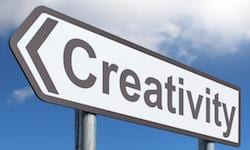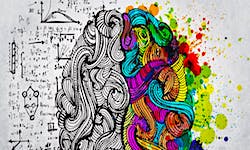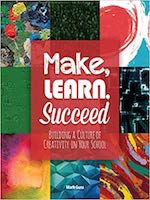https://vimeo.com/286406371
What does creativity actually look like in the classroom?  Mark Gura went to public school in New York City in the ‘50s, and he says it was very much about compliance and conformity with very little tolerance for kids exploring and using their imaginations. “Kids like me tended to explore our creativity under the desks, so to speak,” Mark says. I recently sat down with him to talk about teaching creativity to students, the subject of his new book Make, Learn, Succeed.
Mark Gura went to public school in New York City in the ‘50s, and he says it was very much about compliance and conformity with very little tolerance for kids exploring and using their imaginations. “Kids like me tended to explore our creativity under the desks, so to speak,” Mark says. I recently sat down with him to talk about teaching creativity to students, the subject of his new book Make, Learn, Succeed.
Mark ended up spending over a decade and a half teaching Visual Arts in the New York City Public School system before moving up into senior leadership positions. He has the experience and gravitas to form an accurate definition of the different types of student creativity. When he talks with someone about creativity, they usually conjure up in their mind the legend of Archimedes and his hot tub “Eureka!” moment. They view it as some inspired bit of genius like a lightning bolt that strikes suddenly and unexpectedly, and not as a talent or power that can be consciously engaged and used at will. Teaching students about inspiration and how to tap into it on demand requires a different definition of creativity than most people accept and understand.
Whenever Mark gets together with his art education peers, and the conversation turns to the subject of student creativity, he finds that the very definition has many answers and varied opinions.
Mark discovered a critical definition in one of the most pivotal of the many teaching jobs in his career in the New York City public schools with a group of very difficult students. A few months into a job teaching art in a school for youthful offenders, a few things became apparent very quickly. “I noticed they seemed to have a very small repertoire of responses,” Mark said. If a peer or classmate said something to them, up went the fists. If an adult said something to them, they would overreact and storm out of the classroom slamming doors. “It was just an automatic response that was so dramatic and exaggerated,” Mark says. “I got onto this idea that maybe I could make these kids more creative in their responses and their lives through teaching art.”
 Mark developed a course of various creative exercises through visual arts to spontaneously create a unique response to a confrontation or critical comment as opposed to merely reaching into their little manual of two or three stock responses. While not 100 percent successful, Mark saw a large percentage of his troubled students broaden their horizons and learn to use their creativity to find emotional outlets to safely channel their anger and frustrations in a healthy way.
Mark developed a course of various creative exercises through visual arts to spontaneously create a unique response to a confrontation or critical comment as opposed to merely reaching into their little manual of two or three stock responses. While not 100 percent successful, Mark saw a large percentage of his troubled students broaden their horizons and learn to use their creativity to find emotional outlets to safely channel their anger and frustrations in a healthy way.
In his book Make, Learn, Succeed, Mark contrasts the different definitions of creativity with the team of designers at NASA and Apple. In Mark’s mind, that’s very much the type of creativity we want to develop in students. It’s collaborative, it’s process-driven, and it’s goal-oriented. “All of us are living in a world in which we have to be creative on demand already,” Mark states. “We just need to train ourselves to be creative continually as a way of being, rather than as a special event.”
Mark says we have a conundrum in education where we need a curriculum driven by creativity that has the unenviable task of teaching skills yet to be invented. He predicts that they are not necessarily skills that students are going to get from teachers, but rather, students are going to get them from an inquiry-oriented means to meet the wants and needs they see in society.
He warns that to achieve this, we as educators need to radically shift our mindset in measuring student learning and success. “We are in this mode in education where we want to have quantifiable results through standardized testing, and that’s usually not associated with creativity,” Marks says. “We need to be producing problem solvers and innovators in our schools, but even in the standards I don’t see much reference to creativity.” In other words, educators teaching student creativity have their work cut out for them.
About Mark Gura
 Mark Gura taught visual art in NYC public schools for 17 years before becoming involved in EdTech. Moving beyond his own classroom, he continued as a staff and curriculum developer and Arts and Technology leader for New York schools, citywide, eventually becoming the Director of the Division of Instructional Technology for the entire New York City school system. Subsequently, he has written numerous books (6 for ISTE) on a variety of instructional themes, including technology and Visual Art, Literacy, Student Robotics, Developing Student Creativity, and Educational Leadership.
Mark Gura taught visual art in NYC public schools for 17 years before becoming involved in EdTech. Moving beyond his own classroom, he continued as a staff and curriculum developer and Arts and Technology leader for New York schools, citywide, eventually becoming the Director of the Division of Instructional Technology for the entire New York City school system. Subsequently, he has written numerous books (6 for ISTE) on a variety of instructional themes, including technology and Visual Art, Literacy, Student Robotics, Developing Student Creativity, and Educational Leadership.
He has also written numerous articles for a variety of journals and magazine in the field, including Edutopia, Learning & Leading with Technology, Converge, T.H.E. Journal, and others. He also currently teaches graduate level Education courses for several prominent universities. Mark’s numerous blogs include Lighting the Fire, Classroom Robotics, and his personal blog, Mark Gura’s Blogspot. Follow Mark on Twitter.

AuthorDr. Berger is one of many industry education correspondents for the Mind Rocket Media Group, An educator and former school administrator. His video interview work and conversational podcasts have been featured in various media outlets. He often hosts education panel discussions and develops strategic content. As an academic Dr. Berger is a guest lecturer at Vanderbilt University’s Owen Graduate School of Management. A former assistant principal, he has been an adjunct undergraduate professor and developer of online college courses. He is a passionate Detroit sports fan who has also adopted Nashville sports teams as his own.
Contact the Mind Rocket Media Group if you are interested in an industry interview and a placement on EdCircuit.
.
- TeachThought – 30 Ideas To Promote Creativity In Learning
- Forbes – Teaching Creativity Is A Necessary Part Of Education
- Scholastic – Teaching Creativity
